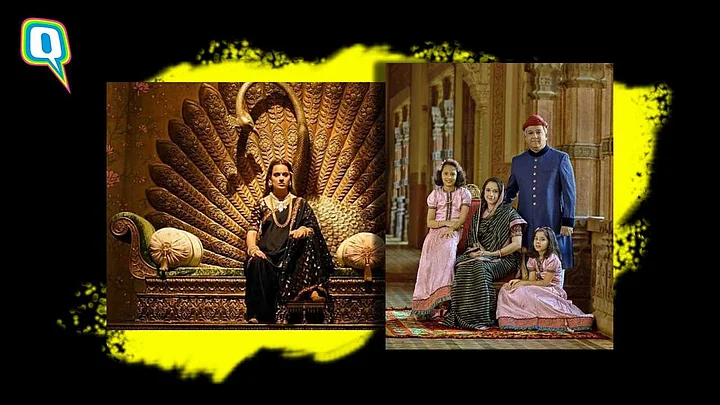As a student of history and daughter-in-law of a Maratha family, Rani Lakshmibai of Jhansi has been in my mind the ideal queen, mother and patriot. Therefore, to have this first feminist warrior of India exhumed out of dusty Hindi text books, Amar Chitra Katha comics and even dustier equestrian-borne statues at traffic roundabouts, was a celluloid moment I wasn’t going to miss.
So far, little is factually known about the human journey of this Indian Joan of Arc who stood against plain colonial bullying. So, for no other merit, ‘Manikarnika: The Queen of Jhansi’ directed by Kangana Ranaut and Radha Krishna Jagarlamudi deserves our attention. And the film holds it too, despite a few slips in authentic depictions. To begin, in the movie we are introduced to Kangana playing a 14-year-old manikarnika, all curves and curls. Her sky blue dhoti pants and endless pallu is blowing in the soft breeze as she holds her bow aiming at a CGI tiger. At that one moment this is Rani of Jhansi playing out Ranaut.
In ‘Manikarnika’, Lakshmibai’s character is never seen evolving from a child bride of 14 to a widowed warrior queen of 29. So, one doesn’t witness the journey and transformation of the queen under what must have been extremely oppressive and rigid societal norms.
Child marriage, purdah, sati and widow segregation are all aspects that as a Maratha noble woman she must have had to endure and resist alternately, and that’s what for me, adds to her legend. Unfortunately, that personal journey is missing in ‘Manikarnika.’
Where Ranaut however resounds, is in her performance as the grief-stricken mother, unrelenting queen and the determined warrior. Herself a self-proclaimed feminist fighting a misogynistic society, no actor could have conveyed these aspects with more conviction and finesse than Kangana herself.
For me, Manikarnika revived some of history’s forgotten feminist figures. Undoubtedly some of India’s most prominent pre independence Hindu women leaders have been Marathas. Shivaji’s mother Jijabai was considered to be the power behind his throne and his younger daughter-in-law Tarabai remained regent for seven years – transforming the disintegrating Maratha confederacy against Aurangzeb’s army into a national force. Rani Ahilyabai Holkar of Indore in her 30-year-long reign from 1767 built ghats, roads and temples from Varanasi to Jagannath Puri, Ayodhya, Dwarka and Somnath; most of which even serve and stand today. All these women paved the path for a strong Maratha female presence in court and society. Baroda too, could boast about the trickle-down effect of this phenomenon.
In 1870 one of the unsung Queens of colonial india, dowager Maharani Jamnabai stood her ground against British pressure to adopt the heir to the throne, Maharaja Sayajirao III. Thankfully, by then the Doctrine of Lapse that had applied in Jhansi had been done away with and Jamnabai was able to lay the foundation of Baroda state without warfare.
Her daughter-in-law Maharani Chimnabai II, was one of the most emancipated Maharanis of her time. She led a public life almost as relevant and influential as her husband’s. She cast away the purdah, encouraged girls’ education and the nationalist fervour and authored a book on the status of women in india. She was also know to be a terrific rider and hunter.
Her daughter, the legendary beauty and rebel, princess Indiraraje was considered one of the most beautiful, stylish and liberated women of her times. Indiraraje represented the modern Baroda princess. She was educated in England and traveled widely with her parents. After a chance meeting with the young prince Jeetendra Narayan of Cooch Behar at the 1911 Dilli Durbar, love blossomed and she called off her engagement with the Gwalior Maharaja. Widowed young, she also served as regent of Cooch Behar for her son, Maharaja Jagdeependra Narayan.
The Maharani to succeed Chimnabai II was my grandmother-in-law, Maharani Shantadevi. She was periodically an acting regent of the state; the only lady in the dynasty to receive this honour. Although we have no documentation of portraiture and costume dating as far back as the mutiny, our own family portraits from the 1800s onwards show strong feminist depictions of royal women – their stance sometimes almost masculine.
Unlike as seen in ‘Manikarnika,’ all royal women are seen in Benarasi, Chanderi or Paithani in portraits available, as only handlooms were available and worn up until the late 19th century. For outings such as hunting and riding, maheshwari was the choice of saree as the fabric was sturdier and less transparent. Needless to say the pallu always stayed over the shoulder, if not on the head. This indicates that however revolutionary a role they played in society, dressing for the women in royal families remained conservative and in accordance with the royal standards.
All the same, Lakshmibai’s life and legacy exploded every stereotypical notion of women in pre-Independence india and laid the foundation for future reforms, especially the dissolution of the demonic Doctrine of Lapse. As a daughter in law of the house of Baroda, I feel extremely privileged to have these generations of Maratha matriarchs who stood their ground against social evils and political pressures to set the stage for today, where my two daughters Padmaja and Narayani, and I will never have to choose between life and liberty.
(At The Quint, we question everything. Play an active role in shaping our journalism by becoming a member today.)
